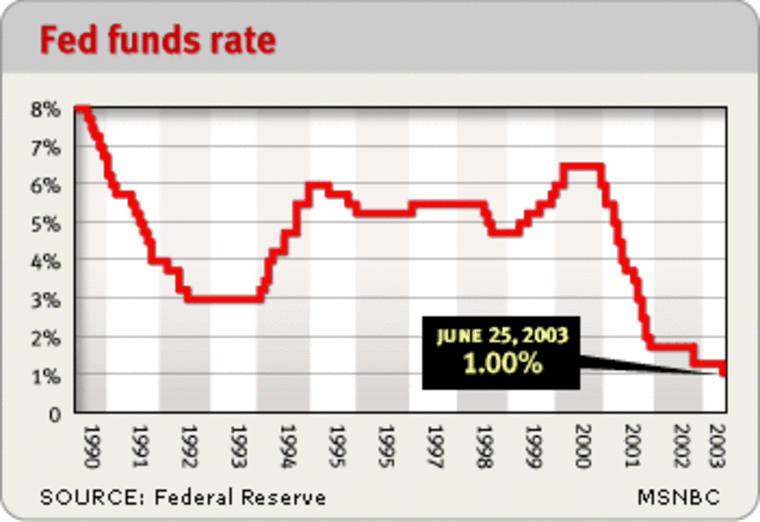The Federal Reserve under Chairman Alan Greenspan has made a virtue of transparency, opening a wider window onto the thinking of central bankers. But the words and actions of Fed policy-makers this week left Wall Street in a muddle as Greenspan and his colleagues play out a tricky monetary end game.
By cutting a key interest rate a quarter-point Wednesday, the Fed gave Wall Street half a loaf, delivering on expectations for a rate cut but disappointing many investors who had been expecting a larger half-point move. Fed rate-setters, who deliberated for two days before acting, accompanied the move with a statement that left analysts a bit confused but appeared to leave the door open for at least one more rate cut.
The Fed seems to be struggling as it moves through uncharted waters, analysts say, with interest rates at their lowest levels in 45 years, growth prospects uncertain and deflation the main apparent risk rather than inflation.
“It is confusing what the Fed is up to,” said Ethan Harris, chief U.S. economist at Lehman Bros. “They’ve spent a lot of time marketing the idea that they’ve got a lot of ammunition left. … And we know that some of that is whistling in the dark.”
Since last fall, central bankers have been increasingly vocal about their willingness to pursue unconventional options as the benchmark federal funds rate, now at 1 percent, approaches its limit of zero. Yet both this week and in its previous rate cut in November the Fed has shown some hesitancy to act aggressively.
If the funds rate were higher, the Fed would have eased multiple times this year, given the sluggish economy and steady loss of jobs, Harris said. “The only explanation for why they’re not easing is that they’re getting nervous around this end game for monetary policy,” he said. “They are supposed to err on the side of easing too much.”
Harris and other economists said it would help if the Fed would be more explicit about its intention to leave short-term rates at their current low levels for an extended period, perhaps late into 2004, to ensure that inflation reverses its current downward course. By giving investors room to question the Fed’s long-term intentions, the central bank undermined financial market strength, sending stocks down 2 percent for the week and boosting long-term interest rates by nearly half a percentage point.
Neal Soss, chief U.S. economist for Credit Suisse First Boston, said Fed policy-makers have to be disappointed that financial market conditions tightened even as they eased rates. He blamed the Fed for what he called “a failure to communicate.”
“The fact that this episode devolved into a big debate over 25 or 50 basis points of easing was the essence of the problem,” Soss said. “It was a distraction from the real message, which is that (they) are going to keep it there for a long time.”
He said market participants are responding to the Fed as if it is engaged in traditional monetary policy, in which the central bank begins pushing short-term rates back up at the first signs of growth. But in its zeal to fight the potential emergence of deflation, the Fed has adopted a new doctrine that is “completely tolerant of growth,” he said.
“They need to speak more clearly,” he said. “The message that should have been emphasized is the fixity, the constancy of the low rate rather than the moving of the target.”
The division on Wall Street over the Fed’s intentions reflects differing views on the state of the economy, which is expected to rebound sharply in the second half of the year but has yet to show much evidence of that strength.
The upcoming holiday-shortened week will be packed with key economic reports including a survey of manufacturers due Tuesday that is likely to show that the battered factory sector expanded in June for the first time in four months. But the politically sensitive unemployment rate could rise to a new nine-year high Thursday, as few analysts believe the economy added a substantial number of jobs in June.
“I think there is general agreement that we’re seeing very little in the actual data that gets you very excited,” said Larry Horwitz, senior economist at Decision Economics in Boston. He said new jobs are key because consumer spending, which accounts for nearly 70 percent of U.S. economic activity, cannot rise from current sluggish growth levels until labor market conditions improve.
He predicted another quarter-point rate cut this year unless the employment picture shows significant improvement, which he defined as 80,000 to 100,000 new jobs a month. The economy has been moving the opposite direction recently, losing an average of 72,000 jobs a month since February.
Tim O’Neill, chief economist for the Bank of Montreal, said the economy will begin to add a substantial number of jobs again by the end of the year as GDP growth rises to a 4 percent rate from its current anemic level of less than 2 percent.
He said the Fed’s decision to move only a quarter-point reflected emerging signs of improvement, including the rallying stock market, and the faith of central bankers that the economy eventually will respond to the “trifecta of stimulus” coming from tax cuts, low interest rates and a weakening dollar.
“Eventually the combination of the stimulus that is there … is going to work its magic,” O’Neill said. “It’s not a question of whether it does. It’s just a question of being patient and waiting.”
